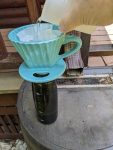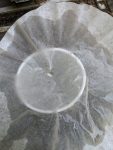By combining water purification and storage, the LifeStraw 22 Ounce Water Bottle provides a simple, convenient and practical solution for providing potable water in the field. With the LifeStraw Go, safe, pleasant-tasting drinking water is close at hand.
The specific model that I tested is no longer available at LifeStraw.com. A slightly different but similar model cost $32.71 at the time of this writing. Or, if you are fast enough, you might be able to still get the discontinued model at rei.com for $25.73. Replacement filters cost $24.95 at LifeStraw.com.
Lifestraw products are manufactured in South Korea, the United States, and Mexico using imported parts.
If you are looking for a filter and water bottle for use in a bug out bag, the LifeStraw Go series of water bottles/filters provide the best combination of which I am currently aware. They are also a great solution for general field use. And if you don’t like the taste of the tap water in your home, the LifeStraw Go is a much better solution than buying expensive bottled water.
Background
A friend recently gave me a LifeStraw Go 22 Ounce Water Bottle as a birthday present. I often use both water filters and water bottles, and was delighted and grateful to receive such a useful and clever present that combined both functions.
First Impressions
The bottle contained a sheet of A4 paper that was folded into a 30 page user manual. The manual contained instructions in English, French, Chinese, and German.
The Lifestraw Go system consists of a bottle, lid, mouthpiece and a two-stage filter consisting of a hollow fiber membrane and a replaceable activated carbon capsule.
The bottle is about 9.13 inches tall at its highest point including the lid when the mouthpiece is not unfolded. It is about three inches wide at its broadest point near the base.
The two-stage filter is rated to remove bacteria, protozoa, bad odor, taste, and some chemicals. It is good for everyday use in areas where water may be unsafe to drink due to contamination by bacteria or parasites.
The carbon capsule should be replaced after it has treated 26.4 gallons of water. The hollow fiber membrane unit of the filter will cease to allow water to pass through it when it needs to be replaced. This will typically take place after it has filtered approximately 1,000 gallons of water.
The manual recommends rinsing the carbon capsule, bottle, cap, and hollow fiber membrane filter with safe water prior to the first use. It also recommends blowing air through the filter after each use to keep it clean and to prevent clogging.
One limitation of the LifeStraw Go design is that the filter may fail to function if it is exposed to extreme heat or freezing temperatures. The Sawyer Mini Water Filtration System and other similar systems have the same limitation. Since field conditions often involve extreme heat or freezing temperatures, gear should be suitable for use in such conditions whenever possible. If any SurvivalBlog readers are aware of water filter systems that tolerate extreme heat and freezing temperatures well, please let me know at ThomasKChristianson at gmail dot com.
The manual also warns against dropping the bottle or hitting it against a hard object. I am happy to report that although I dropped the bottle several times, it survived with no ill effects. The LifeStraw Go 22 Ounce Water Bottle passed the “Thomas Christianson Klutz Test” with flying colors. There are also models of the LifeStraw Go series made of stainless steel, which should significantly enhance their durability.
The manual goes on to mention a number of factors that could recontaminate water after it has passed through the filter:
- using with contaminated hands
- using with a contaminated mouth
- using in a dense coliform environment
- failure to maintain a sterile mouthpiece
sharing between multiple individuals
It is also important to note that the filters used in LifeStraw Go series water bottles cannot remove viruses, salt from seawater, and chemical contaminants from thing like mining trailing ponds or large agricultural operations.
My Testing

 I washed my hands, rinsed the various parts of the filter with safe water, and initially filled the bottle with safe tap water. Over the course of more than a month of use, almost all of the water that I drank came through the LifeStraw Go. Much of the water was safe tap water. Even though the water was already potable, the LifeStraw Go greatly improved its taste. I also topped off the LifeStraw Go with water from our rain barrel. That water was contaminated with plant matter and bird droppings from our roof. The water was yellowish, smelled of sulfur, and had small particles suspended in it. I pre-filtered the water with a coffee filter to extend the life of the hollow membrane filter, and then filled the LifeStraw Go with the pre-filtered water. The water came out of the LifeStraw Go with no color, no offensive odor, and it tasted great.
I washed my hands, rinsed the various parts of the filter with safe water, and initially filled the bottle with safe tap water. Over the course of more than a month of use, almost all of the water that I drank came through the LifeStraw Go. Much of the water was safe tap water. Even though the water was already potable, the LifeStraw Go greatly improved its taste. I also topped off the LifeStraw Go with water from our rain barrel. That water was contaminated with plant matter and bird droppings from our roof. The water was yellowish, smelled of sulfur, and had small particles suspended in it. I pre-filtered the water with a coffee filter to extend the life of the hollow membrane filter, and then filled the LifeStraw Go with the pre-filtered water. The water came out of the LifeStraw Go with no color, no offensive odor, and it tasted great.
I also topped off the LifeStraw Go with water from our well. The water from our well is safe to drink, but it has a slight brownish tinge, a faint odor of sulfur, and tastes of rust. Once again, the LifeStraw Go was able to remove offensive colors, odors, and tastes.
The LifeStraw Go filtered all of the water that I drank while on a five-day camping trip with our daughters, son-in-law, and three grandchildren. The Go did a great job of enhancing the taste of the various water sources that I used throughout the trip.
One day during the trip, we were on a longish (90-minute) boat ride. My granddaughter, “Ginger” amused herself by opening and closing the mouthpiece of the LifeStraw Go more than 100 times. The bottle held up to that somewhat hard use with absolutely no signs of wear and tear. It passed “The Ginger’s Playtime Torture Test” with flying colors.
Partway through my testing, I removed the hollow fiber membrane filter and carbon capsule from the bottle, top, and mouthpiece and then placed the later items into the top rack of our dishwasher for cleaning. Those items withstood the standard dish-washing cycle with with no deformation from the heat, allowing the system to be easily reassembled and returned to use.
About my only complaint about the bottle would be that 22 ounces of water disappears rather quickly. The bottle is quickly and easily refilled during household use. For more serious field use, I would probably recommend one of the various Lifestraw Go models with a greater capacity.
LifeStraw History
The LifeStraw was originally designed for people in developing nations who did not have access to potable water, and for use during humanitarian crises.
The LifeStraw is a product of the Vestergaard Frandson company. That company was founded in Denmark in 1957 in order to manufacture uniforms. The focus of the company gradually shifted to public health, water, and food security products. Eventually, Vestergaard Frandson reached the point where they completely stopped making uniforms and instead concentrated solely on disease prevention and treatment to improve global health outcomes.
The original LifeStraw was introduced in 2005. The company moved from Denmark to Switzerland beginning that same year.
Water Purification History
Water purification methods are first mentioned in ancient Sanskrit writings from about 4000 BC. Similar methods were adopted by the ancient Egyptians, Greeks, and Romans. These methods were primarily concerned with improving the taste of water. These methods included filtering through sand, gravel, and charcoal; filtering through porous ceramic pots; boiling; and exposure to sunlight.
By happy coincidence, these efforts to improve the taste of water often made it safer to drink as well.
During the 1700s, home water filters using media such as wool, sponge, and charcoal were developed.
In 1804, John Gill, a Scottish engineer, developed the first large scale water filtration system using sand. Gill invented the system for industrial purposes, but sold his surplus water for human consumption. His system was soon improved and adopted for treating the water for the city of London.
In the late 1880s, French scientist Louis Pasteur discovered why water filtration could help to prevent illness by demonstrating his germ theory of disease. By helping to removing bacteria from the water, filtration was helping to protect the body from the illnesses caused by those bacteria. Water quality engineers were able to build on this knowledge by introducing small amounts of disinfectants like chlorine into water to kill harmful microbes.
Conclusions
The LifeStraw Go 22 Ounce Water Bottle is an excellent piece of field gear. By combining water purification and storage, it provides a simple, convenient, and practical solution for supplying potable water in the field.
For most field use, I would recommend one of LifeStraw’s stainless steel models for greater durability. I would also recommend one of the larger capacity models for times when water sources may be few and far between.
I would also appreciate reader comments about water filtration systems that tolerate extreme heat and freezing temperatures well.
Disclaimer
I did not receive any financial or other inducement to mention any vendor, product, or service in this article.
Read the full article here

